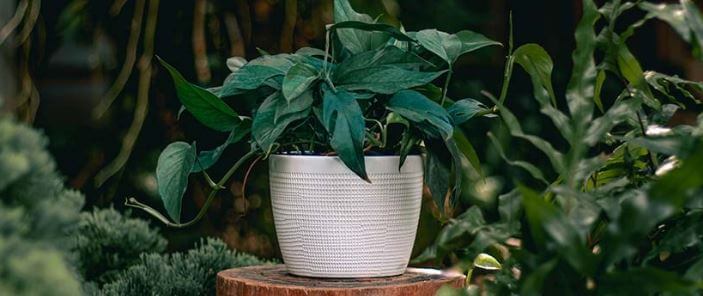Last Updated on January 6, 2023 by a Friendly Gardener
The Baltic Blue plant is a variety of the Epipremnum pinnatum species. Also called the Baltic Blue pothos, this plant tends to have dark green leaves that take on a bluish hue once they begin to grow.
A unique feature of the leaves of this plant is the fact that they develop natural cuts or slits in their shapes as they grow larger. This plant typically begins to grow in vines once enough leaves form, thus requiring a suitable enough location in your home, such as a hanging pot or the support of a trellis or rod.
Propagating and caring for this plant is quite simple as long as you follow some basic instructions. Let’s take a look at what these are.
How to Propagate the Baltic Blue Plant

The Baltic Blue plant is simple to propagate. Its seeds might be easily available through online stores or local nurseries, but these can sometimes also be a bit difficult to source and obtain.
If you already have this kind of plant at home or know someone who has grown it, the best course of action here can be to obtain stem cuttings that are a few inches long and have growth nubs on them.
Here are the steps involved in growing the Baltic Blue plant using stem cuttings:
- You can start off by applying some rooting hormone to the stem cuttings.
- Directly plop each stem in a vase or container of water so that the roots can grow. This particular plant can survive well in water when it comes to developing its roots.
- It can take around three weeks for the roots to form, following which you can transfer the planting into a pot full of soil.
- If you feel more comfortable directly growing the stem cuttings in the soil, you can do so by simply sowing them into the pot filled with soil.
Establishing the plant in the soil in this manner can then lead to healthy growth. Make sure you look after the plant’s needs well and supply water, light, and fertilizer as required.
You can place the potted plant either on a desk that receives enough light or on a balcony or windowsill. You can also use a hanging planter, mirror, shelf, trellis, or curtain rod to allow the vines to creep and curl around the supporting element.
How to Maintain the Baltic Blue Plant

The Baltic Blue plant’s care conditions are easy to follow, especially since this plant can survive a bit of neglect and slightly unsuitable conditions. Of course, for the majority of the growing season, you will need to provide the right kind of support and care for this plant so that it can grow beautifully.
Here are some tips and aspects of this plant’s care that you might benefit from.
Light and Temperature
This plant needs bright and indirect sunlight to thrive, although you can also manage its growth using artificial growing lights. The plant can also survive and continue growing if the lighting levels are low, although this might sometimes alter the color and size of the leaves.
Maintain temperatures around 65°F-80°F for healthier growth, although a few degrees less or more should not present an issue as long as you avoid the extremities on both sides.
Watering
You should water this plant on a regular basis. This can amount to around once in one or two weeks, depending on the climate surrounding the plant. If you are unsure of how to go about establishing a routine, the best rule can be to see if the soil has become mostly dry.
Water the soil only when dry enough. If you forget to water the plant once in a while, this will not be too much of an issue for this plant. On the other hand, the plant can be in trouble if you overwater it, resulting in issues of root rot and discolored leaves.
Soil Requirements
The soil for this plant should be full of organic nutrients. If you can manage to find suitable soil from stores or nurseries, you can make do with this on its own. In other cases, you can also add some materials like sand, peat, moss, perlite, pieces of leaves, and more.
These can help loosen the soil up so that it can drain out some extra water from the pot.
Humidity
You should provide relatively high levels of humidity for this plant, with anywhere between 50% and 70% being ideal. You can rely on the natural air or steam in your rooms (like bathrooms and kitchens) to supply this for you, or you can use a humidifier or a tray filled with water and pebbles.
Fertilizing
You can dilute or weaken the balanced fertilizer that you buy from a store so that it does not prove to be too harsh for the plant. You can then apply it to the soil a couple of times in the growing season (spring and summer) but never in the winter.
Potting Needs

The container or pot should have a hole or two at the base to drain out some water from the soil. Every couple of years or so, you might also need to transfer the plant to a bigger pot.
Pruning

Given that the Baltic Blue plant grows in the form of vines, it is bound to have extremely spindly growth. To keep the plant from becoming too unruly, make sure you prune some older leaves and stems right before every growing season. Cut off the dead leaves occasionally too.
Pests
Pests like mealybugs, scales, mites, and aphids, among other insects, can damage your plant if the conditions surrounding your plant’s growth are unfavorable. Apart from the aforementioned conditions, make sure you maintain ventilation around the plant too.
Concluding Words
Propagating and maintaining the Baltic Blue plant is not a tough process, but can certainly require some sort of care routine along with suitable conditions.
With bright and indirect light, dry soil between watering sessions, regular pruning, and occasional fertilizing, you can ensure that this plant exhibits its deep blue-green leaves with pride.


